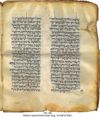Laban
 From Conservapedia
From Conservapedia Laban (Hebrew: לָבָן, Lavan, Lāḇān "white") is a direct ancestor of the house of Israel. But his story is marked largely by fraud, committed by him and against him.
Contents
- 1 Family
- 2 Marriage of Rebekah
- 3 Encounter with Jacob
- 4 Flight of Jacob
- 5 References
- 6 See also
Family[edit]
Laban was the son of Bethuel, who was the youngest son of Nahor and Milcah. He is commonly called the Aramean, or the Syrian, because he lived in Padan-aram, the country of Aram.
His sister was Rebekah, who married Isaac in 2148 AM (1857 BC). Ninety-seven years later, he would meet Jacob, who would marry his two daughters, Rachel and Leah.[1][2][3][4]
The Bible gives no dates for Laban's birth or death. The key dates from the lives of Isaac and Jacob indicate that he may have lived for a span of time between 140 and 150 years. This is consistent with the life spans of Isaac and Jacob. However some Jewish literature identifies Laban with more than one person.[4]
Marriage of Rebekah[edit]
In 2148 AM, Eliezer of Damascus, steward of Abraham, came to Padan-aram to seek a wife for Isaac. Rebekah met him first and received from him three expensive pieces of jewelry. This impressed Laban and his father Bethuel, and so Laban rushed to the community well to welcome Eliezer and invite him to lodge at his house. Some rabbinical passages accuse Laban of intending to murder Eliezer.[4] Flavius Josephus says no such thing,[5] and neither does any other source.
In any case, Laban concluded the negotiations with Eliezer and ultimately said that God must have ordained the events, and for that reason Laban and Bethuel should say nothing good or bad about the marriage. He gave his consent, and Rebekah left Padan-aram to marry Isaac.[6]
Encounter with Jacob[edit]
In 2245 AM (1759 BC), Jacob, son of Isaac, came to Padan-aram, also to seek a wife. Jacob met Rachel, Laban's younger daughter, at the community well. He rolled the stone from the well and watered the sheep that Laban had sent to the well with Rachel.
Laban consented to a marriage between Jacob and Rachel, on condition that Jacob serve Laban for seven years. Jacob agreed. But when the customary time had elapsed for a wedding, Laban substituted his older daughter Leah for Rachel. When Jacob protested, Laban said that he could not in good conscience allow a younger daughter to marry ahead of an older one. He then said that Jacob could marry Rachel also, if he would agree to serve Laban for an additional seven years. Jacob agreed to this as well.[7]
In 2259 AM (1745 BC), Jacob had served his original fourteen years. But Laban was reluctant to see Jacob leave. So he offered Jacob whatever wage he wished, if Jacob would serve Laban for six more years. Jacob asked for any sheep, goats, or cattle that were spotted or discolored in any way. Jacob then prepared rods of green poplar, hazel, and chestnut wood, with white streaks, and set them in places where the strongest of the animals would drink or conceive. In that manner Jacob became very rich at Laban's expense.[8] (Genesis 30:26-43 )
Flight of Jacob[edit]
By the year 2265 AM (1739 BC), Laban and Jacob had grown extremely suspicious of one another. Then suddenly Jacob left Laban, and took Leah, Rachel, the two maids that Laban had given to Jacob, and all his cattle. Laban also discovered that someone—he never discovered who—had stolen Laban's household idols. Laban pursued Jacob and caught up with him after seven days. Laban accused Jacob of the theft of his idols, and Jacob indignantly invited Laban to search his camp for them. Laban searched, and found nothing. At last Laban and Jacob agreed to part ways, and build a cairn of rocks, called Gilead, or "the witness cairn," to seal the agreement.[9]
References[edit]
- ↑ Blank, Wayne. "Bible Study: Laban." Church of God Daily Bible Study, n.d. Accessed November 7, 2008.
- ↑ Blank, Wayne. "Bible Study: Jacob and Laban." Church of God Daily Bible Study, n.d. Accessed November 7, 2008.
- ↑ Albert, Francis X.E. "Laban." The Catholic Encyclopedia. Vol. 8. New York: Robert Appleton Company, 1910. Accessed November 7, 2008.
- ↑ 4.0 4.1 4.2 Hirsch EG, Seligsohn M, and Schechter S. "Laban." The Jewish Encyclopedia, 2002. Accessed November 7, 2008.
- ↑ Josephus, Antiquities, I.16.1-3
- ↑ Ussher, James. The Annals of the World. Green Forest, AR: Master Books, 2003 (ISBN 0890513600), pgh. 94.
- ↑ Ussher, op. cit., pghh. 115-116.
- ↑ Ussher, op. cit., pgh. 122
- ↑ Ussher, op. cit., pgh. 125
See also[edit]
- Israel
- Arabs
- Palestine
| |||||||||||||||||||
Categories: [Book of Genesis Persons]
↧ Download as ZWI file | Last modified: 02/10/2023 05:48:40 | 38 views
☰ Source: https://www.conservapedia.com/Laban | License: CC BY-SA 3.0
 ZWI signed:
ZWI signed:
 KSF
KSF